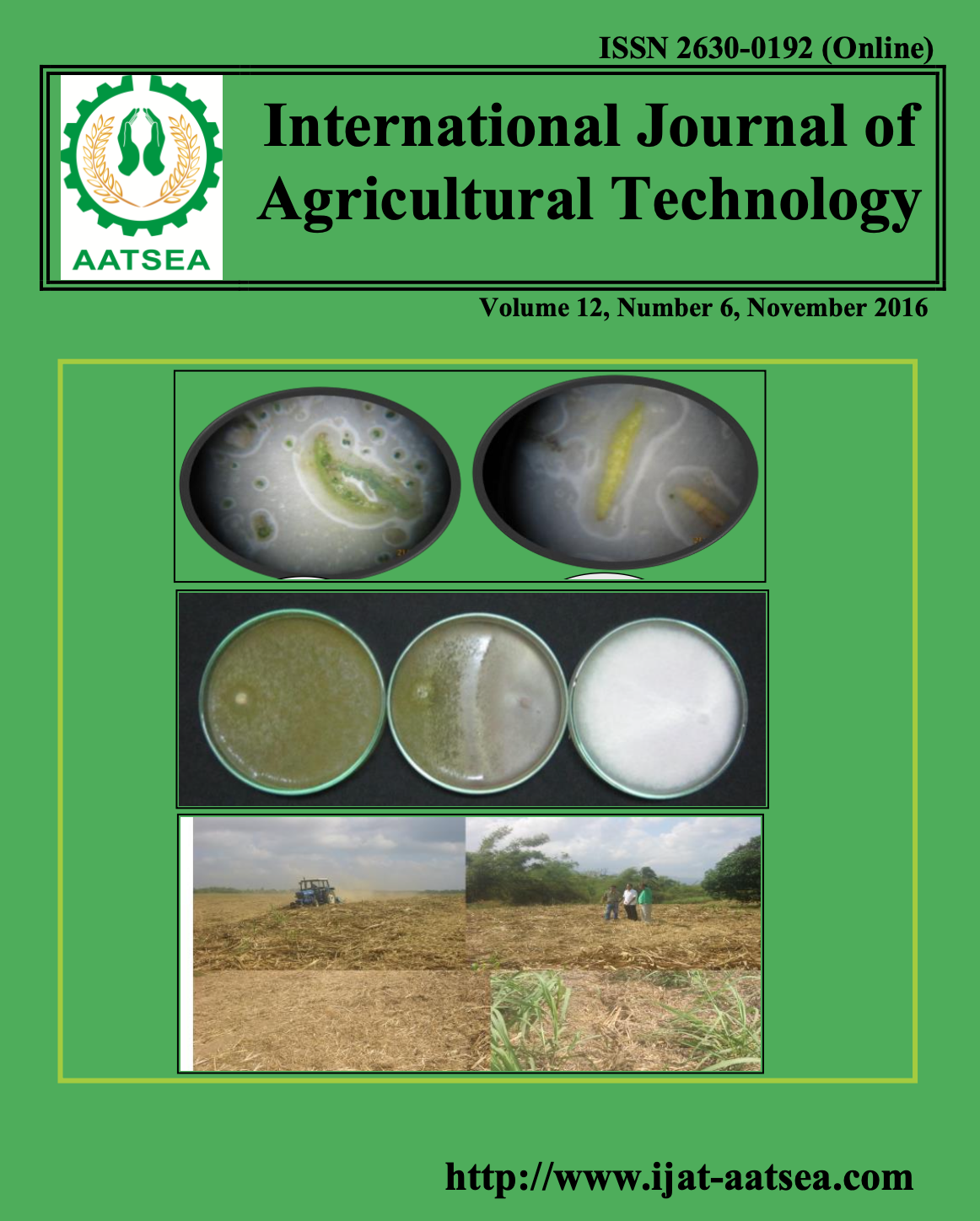Effect of storage time on some quality parameters of calamondin (Citrus madurensis Lour.) squash stored at room temperature.
Main Article Content
Abstract
Calamondin is a citrus fruit; known as one of the healthiest fruits suitable to make a drink, not only due to its high vitamin C content, but also its distinctive aroma and test. This study reported for some physical, chemical, and microbiological properties of 43oB and 60oB calamondin squash during 10-week storage at room temperature. The results showed that the L* values of 43oB and 60oB calamondin squash varied between 6.17-9.02 and 3.04-8.76, respectively. On week 6-10, b* values showed significantly lower compared to b* values on week 0. The sediment appeared on top of the bottle during storage. Storage time had no effect on total soluble solid and pH. Titratable acidity and ascorbic acid content declined with increase in storage duration on weeks 2-6. After 10 weeks, total microorganism including yeast and molds of calamondin squash were in the standard level.
Article Details

This work is licensed under a Creative Commons Attribution-NonCommercial-NoDerivatives 4.0 International License.
References
Abeysinghe, D. C., Li, X., Son, C., Zhang, W., Zhou, C. H. and Chen, K. (2007). Bioactive compounds and antioxidant capacities in different edible tissues of citrus fruit of four species. Food Chemistry 104:1338-1344.
Agcam, E., Akyildiz, A. and Eurendilek, G. A. (2016). A comparative assessment of long-term storage stability and quality attributes of orange juice in response to pulsed electric fields and heat treatments. Food and Bioproducts Processing 99:90-98.
AOAC (2000). Official methods of analysis. 17th edition. Association of Official analytical chemists. USA.
Bull, M. K., Zerdin, K., Howe, E., Goicoechea, D., Paramanandhan, P. and Stockman, R. (2004).The effect of high pressure processing on the microbial, physical and chemical properties of Valencia and Navel orange juice. Innovative Food Science and Emerging Technologies 5:135-149.
Chen, H. C., Peng, L. W., Sheu, M. J., Lin, L. Y., Chiang, H. M., Wu, C. T., Wu, C. S. and Chen, Y. C. (2013). Effects of hot water treatment on the essential oils of calamondin. Journal of Food and Drug Analysis 21:363-368.
Cheong, M. W., Zhu, D., Sng, J., Liu, S.Q., Zhou, W., Curran, P. and Yu, B. (2012). Characterisation of calamansi (Citrus microcarpa). Part II: Volatiles, physicochemical properties and non-volatiles in the juice. Food Chemistry 134:696-703.
Choi, M. H., Kim, G. H. and Lee, H. S. (2002). Effects of ascorbic acid retention on juice color and pigment stability in blood orange (Citrus sinensis) juice during refrigerated storage. Food Research International 35:753-759.
del Socorro Cruz-Cansino, N., Ramírez-Moreno, E., León-Rivera, J. E., Delgado-Olivares, L., Alanís-García, E., Ariza-Ortega, J. A., de Manríquez-Torres, J. J. and Jaramillo-Bustos, D. P. (2015). Shelf life, physicochemical, microbiological and antioxidant properties of purple cactus pear (Opuntia ficus indica) juice after thermoultrasound treatment. Ultrasonics sonochemistry 27:277-286.
Desai, B. B. (2000). Handbook of Nutrition and Diet. Marcell Dekker, Inc. New York. 231pp.
Elez-Martinez, P., Soliva-Fortuny, R. C. and Martin-Belloso, O. (2006). Comparative study on shelf life of orange juice processed by high intensity pulsed electric fields or heat treatment. European Food Research and Technology 222:321-329.
Fustier, P., St-Germain, F., Lamarche, F. and Mondor, M. (2011). Non-enzymatic browning and ascorbic acid degradation of orange juice subjected to electroreduction and electro-oxidation treatments. Innovative Food Science and Emerging Technologies 12:491-498.
Ibrahim, G. E., Hassan, I. M., Abd-Elrashid, A. M., El-Massry, K. F., Eh-Ghorab, A. H., Ramadan Manal, M. and Osman, F. (2011). Effect of clouding agents on the quality of apple juice during storage. Food Hydrocolloids 25:91-97.
Khandpur, P. and Gogate, P. R. (2016). Evaluation of ultrasound based sterilization approaches in terms of shelflife and quality parameters of fruit and vegetable juices. Ultrasonics Sonochemistry 29:337-353.
Tannenbaum, S. R., Young, V. R. and Archer, M. C. (1985). Vitamins and Minerals. Food Chemistry. Second edition. Marcel Dekker, Inc. New York. USA. pp. 477-544.
Ladaniya, M. S. (2008). Commercial fresh citrus cultivars and producing countries. Citrus fruit : Biology, Technology and Evaluation. Academic Press. Elsevier Inc. India. pp.13-65.
Nisperos-Carriedo, M. O., Baldwin, E. A., Moshonas, M. G. and Shaw, P. E. (1992). Determination of volatile flavor components, sugars, and ascorbic, dehydroascorbic, and other organic acids in calamondin (Citrus mitis Blanco). Journal of Agricultural and Food Chemistry 40:2464-2466.
Pala, C. U. and Toklucu, A. K. (2014). Microbial, physicochemical and sensory properties of UV-C processed orange juice and its microbial stability during refrigerated storage. LWT – Food Science and Technology 50:426-431.
Pasupuleti, V. and Kulkarni, S. G. (2013). Lycopene fortification on the quality characteristics of beverage formulations developed from pink flesh guava (Psidium guajava L.). Journal of Food Science and Technology 51:4126-4131.
Phillips, K. M., Council-Troche, M., McGinty, R. C., Rasor, A. S. and Tarrago-Trani, M. T. (2016). Stability of vitamin C in fruit and vegetable homogenates stored at different temperatures. Journal of Food Composition and Analysis 45:147-162.
Rouseff, R. L., Perez-Cacho, P. R. and Jabalpurwala, F. (2009). Historical review of citrus flavor research during the past 100 years. Journal of Agricultural and Food Chemistry 57:8115-8124.
Silva, F. V. and Gibbs, P. (2004). Target selection in designing pasteurization process for shelf-stable high-acid fruit products. Critical Reviews in Food Science and Nutrition 44:353-360.
Squash. (n.d.). In Wikipedia. Retrived from https://th.wikipedia.org/wiki/Squash.
Wibowo, S., Grauwet, T., Santiago, J. S., Tomic, J., Vervoort, L., Hendrickx, M. and Loey, A. V. (2015). Quality changes of pasteurised orange juice during storage: A kinetic study of specific parameters and their relation to colour instability. Food Chemistry 187:140-151.
Tiwari, B. K., Patras, A., Brunton, N., Cullen, P. J. and O’Donell, C. P. (2010). Effect of ultrasound processing on anthocyanins and color of red grape juice. Ultrasonics Sonochemistry 17:596-604.
Yeom, H. W., Streaker, C. B., Zhang, Q. D. and Min, D. B. (2000). Effect of pulsed electric fields on the quality of orange juice and comparison with heat pasteurization. Journal of Agricultural and Food Chemistry 48:4597-4605.


